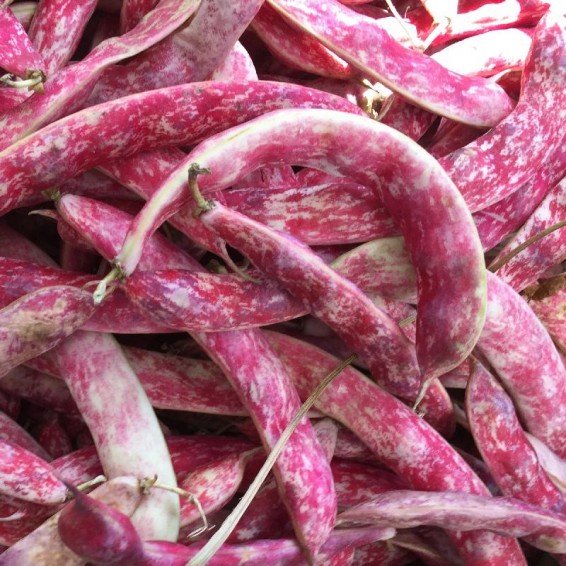French Horticulture Green Bush Bean Seeds
- HOW TO GROW
- FAST FACTS
- REVIEWS
HOW TO GROW
Sowing: Direct sow seeds oustide at least 1 week after the last frost, since beans are quite sensitive to cold. French Horticulture green bush bean seeds should be planted in rich, well-drained soil with full sun exposure. If you have never planted beans in your garden before, treat the seeds with a powder inoculant to allow the process of nitrogen fixation to begin. Sow the seeds 1" deep and 3" apart, in rows 2'-3' apart, and press down the earth above them for good soil contact. These seeds rot easily in wet soil, so do not over water them. Germination should take place 7-12 days after planting. For companion planting benefits, plant bush beans near carrots, cucumbers, or corn; avoid planting them near onions.
Growing: After germination, maintain soil moisture; beans have shallow roots, and need water at least once a week if the weather is dry. Mulching the plants helps conserve moisture and discourages weeds.
Harvesting: Expect your first beans about ten weeks after germination. Daily harvesting improves production; for best flavor and tenderness, pick the beans when they are no larger than a pencil in thickness, or from 4-8" long. Serve or preserve the same day you harvested them for the freshest taste.
Seed Saving: Near the end of the growing season, allow the beans to dry completely on the vine; the pods will be light brown, and the seeds will rattle inside. Remove the seeds from the pods. After French Horticulture green bush bean seeds are completely dry, store them in a cool, dry place for up to a year.
FAST FACTS
Latin Name: Phaseolus vulgaris
Type: Open Pollinated, Warm Season
USDA Zones: 3, 4, 5, 6, 7, 8, 9, 10, 11, 12
Seeds per Ounce: 50
Planting Method: Direct Sow
Sunlight: Full Sun
Height: 18 Inches
Color: Pink, Yellow, Green
Hard to seed
I was so excited to find the seed I wanted! Excellent service and my seed arrived on time! Will be ordering from Everwild again!
Satisfied
I was satisfied with how easy & quick the site & the fast delivery. But would like to see a larger selection of tomato seed & other seeds.
DESCRIPTION
HOW TO GROW
Sowing: Direct sow seeds oustide at least 1 week after the last frost, since beans are quite sensitive to cold. French Horticulture green bush bean seeds should be planted in rich, well-drained soil with full sun exposure. If you have never planted beans in your garden before, treat the seeds with a powder inoculant to allow the process of nitrogen fixation to begin. Sow the seeds 1" deep and 3" apart, in rows 2'-3' apart, and press down the earth above them for good soil contact. These seeds rot easily in wet soil, so do not over water them. Germination should take place 7-12 days after planting. For companion planting benefits, plant bush beans near carrots, cucumbers, or corn; avoid planting them near onions.
Growing: After germination, maintain soil moisture; beans have shallow roots, and need water at least once a week if the weather is dry. Mulching the plants helps conserve moisture and discourages weeds.
Harvesting: Expect your first beans about ten weeks after germination. Daily harvesting improves production; for best flavor and tenderness, pick the beans when they are no larger than a pencil in thickness, or from 4-8" long. Serve or preserve the same day you harvested them for the freshest taste.
Seed Saving: Near the end of the growing season, allow the beans to dry completely on the vine; the pods will be light brown, and the seeds will rattle inside. Remove the seeds from the pods. After French Horticulture green bush bean seeds are completely dry, store them in a cool, dry place for up to a year.
FAST FACTS
Latin Name: Phaseolus vulgaris
Type: Open Pollinated, Warm Season
USDA Zones: 3, 4, 5, 6, 7, 8, 9, 10, 11, 12
Seeds per Ounce: 50
Planting Method: Direct Sow
Sunlight: Full Sun
Height: 18 Inches
Color: Pink, Yellow, Green
Reviews
Review
Hard to seed
I was so excited to find the seed I wanted! Excellent service and my seed arrived on time! Will be ordering from Everwild again!
Review
Satisfied
I was satisfied with how easy & quick the site & the fast delivery. But would like to see a larger selection of tomato seed & other seeds.




